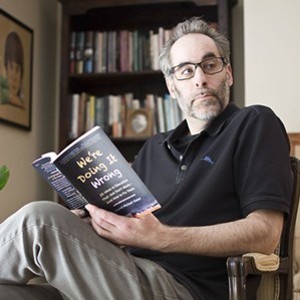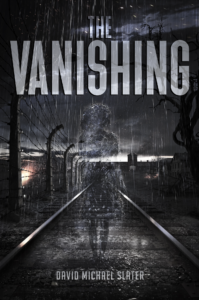David Michael Slater’s new YA novel THE VANISHING (Library Tales Publishing, 2022) is a unique blend of magical realism and historical fiction. Set during the Holocaust, the book centers around an invisible girl named Sophie who is determined to save her best friend Giddy from the Nazis. Sophie’s journey is fraught with challenges, but her love and loyalty never waver. The book features gripping scenes that are raw, emotional, and sometimes violent. It is a heart-wrenching, disturbing, and deeply compelling story that will stay with readers. (Please note, there is a warning at the beginning of the novel that it may not be appropriate for young and/or sensitive readers.)
I was interested to learn about David’s creative choices and his writing process for THE VANISHING. Welcome, David.
THE VANISHING is a YA Holocaust story told through the eyes of Sophie, an invisible protagonist. As a writer, how did you balance the magical realism elements with violence and terror?
For this book, they seem inseparable; I felt it would take a horrific incident of violence to make Sophie’s transformation, if not plausible, somehow believable. And, to me, there’s a surreal nature to Nazi brutality that makes the Holocaust feel almost otherworldly–as if it took place in an alternate universe with different rules. In that context, magical elements don’t seem out of place at all. At the same time, I didn’t want to lose sight of the fact that it all happened in this world, our world.

The heart of the story is the friendship between Sophie and Giddy. Sophie’s invisibility allows her to help Giddy survive, but more often than not backfires with difficult consequences. Her journey is fraught with challenges, but she never gives up. Can you tell me a bit about what inspired these characters and their relationship?
Giddy was not in my first conception of The Vanishing, which I imagined would be the story of a lone invisible girl’s attempts to make a difference during the Holocaust. I did, from the start, envision that most of Sophie’s efforts would be futile, but it quickly became obvious to me that relentless failures in the face of so much suffering would wear a reader out. So I decided that, even if she mostly failed to make dramatic changes for large numbers of victims, she could make a dramatic difference for some, especially one. And that’s when Giddy was “born.” It’s their inspiring relationship that I think motivates readers to persevere through an otherwise difficult reading experience.
THE VANISHING is unequivocally disturbing from the first pages. You did not hold back violent details or water down the truth of the trauma that victims experienced. Can you tell me a bit about this decision?
I went about writing the book simply as it came. Perhaps, as mentioned above, because a brutal scene felt necessary to trigger Sophie’s vanishing, it naturally flowed that the rest of the telling would be equally disturbing. Another answer is that I followed a piece of common advice writers receive: write the book you’d want to read. I should also mention that I was never sure whether I was writing a book for young adults or adults, and there was much debate about how to classify it when it was done. In the end, it seems that because the protagonist is a teen, it is, virtually by default (according to the market), a YA book, and once we decided to put a warning at the start, we all felt comfortable with the decision. I know that many adults won’t pick up a book labeled YA, and I would regret folks not reading it for that reason. The Vanishing is for anyone who can handle it.
Your images of people, places, and events are very descriptive and very specific. What was your research process like?
I am not, and would never claim to be, a Holocaust scholar, but I have been exposed to Holocaust education off and on for most of my life. The situations in this book are based on the reading and learning I’ve done that impacted me the most. Once I began to put those on paper, I turned to research to flesh out as many authentic details as I could. And I’d be remiss if I didn’t mention that I had help with certain details from several experts in the field. All that said, as I explain in the author’s note, the book is not meant to be a historically accurate representation (for example, in service of efficient storytelling, Sophie’s ghetto, camp, and woods are all set in Germany), but rather a story that captures the emotional realities of the time. This approach is not for everyone, and I respect that.

What do you hope your readers come away with after experiencing THE VANISHING?
The honest truth is that, as much as it gratifies me to hear from reviewers and early readers that The Vanishing is an important contribution to the field of Holocaust literature and education, I didn’t set out to write a book to teach readers about the Holocaust. I set out to tell a compelling story based on what I thought was a terrific premise: an invisible person caught up in the Holocaust. So my primary hope is that readers put the book down and feel moved by a powerful story. If The Vanishing helps put any dent at all in the woeful statistics both in the US and worldwide regarding people’s knowledge of The Holocaust, especially in the midst of an alarming rise in antisemitism, that will be truly humbling.
Thank you, David.
*THE VANISHING has been optioned for film. Read about it here.
David Michael Slater is an acclaimed author of nearly thirty books of fiction and nonfiction for children, teens, and adults. He teaches in Reno, Nevada, where he lives with his wife, Heidi. You can learn more at www.davidmichaelslater.com.